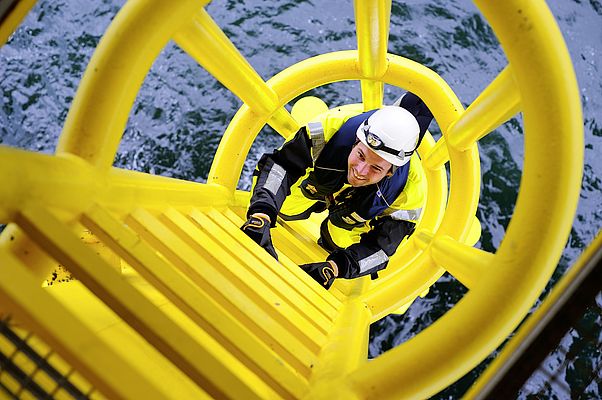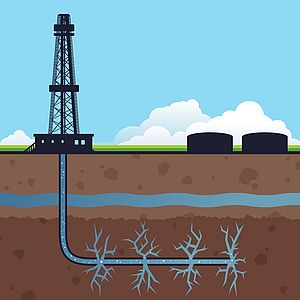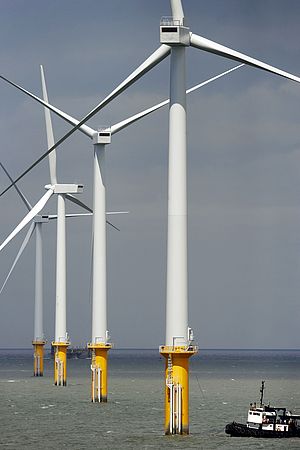A successful energy transition is unthinkable without wind energy. It provides the necessary tailwind for renewables. And it's blowing hard. There has never been so much total capacity installed worldwide. The order books of manufacturers are well-filled, and the technology is mature. During the opening of the DanTysk wind farm, German economics minister Sigmar Gabriel emphasised the technology had left its fledgling stage and was now industrialising. Valve manufacturers are playing their part in the energy turnaround, also in Germany.
Wind power is playing in the Champions League of renewables: according to the Global Wind Energy Council (GWEC) 318,137 MW of wind energy capacity were installed worldwide end of 2013, 2014 around 45,000 MW were added. The record is impressive, especially considering the worldwide capacity was around 20,000 MW back in 2000. GWEC believes that wind energy will be able to provide 25 to 30 percent of global power demand by 2050.
Wind power plants set record highs
Wind power plants are setting record highs mainly in Europe, followed by Asia and North America. China, however, could expand its wind power plants, meaning Asia would overtake Europe. In Germany alone, 24,867 wind turbines produced power free of emissions and environmentally friendly. In 2014, total capacity summed up to 38,115 MW, reports the German Wind Energy Association.As a matter of course, the mechanical and plant engineering industry has long discovered wind energy, the longest serving form of energy known to mankind, as a motor for business. For German minister Gabriel, wind energy has already become a flagship technology for Germany's mechanical engineering sector.
Valves for turbines and transformer platforms
Valve manufacturers are also hoping for a fresh breeze, and justifiably so. Only valves let a wind turbine run smooth. They are installed in turbines, transformer platforms, onshore grid feed and on jack-up vessels. Valves are used in cooling circuits, fire-extinguishing systems, pressure boosting systems, cleaning systems, as well as for tank filling and seawater intake.
Requirements in rough environments are accordingly high, emphasises valve and pump manufacturer KSB. The components partly need to withstand strong and changing wind pressures, as well as fluctuating temperatures. Salty seawater also is a challenge for materials and technology.
In onshore and offshore turbines, valves mainly are used to control and shut-off cooling circuits, fire extinguishing systems and seawater intake. Especially shut-off valves are often used - for instance in front of or behind the drivetrain, generator, transformer, converter, cubicle, pressure and water tank. In addition, adds KSB, check valves are fitted behind the water and pressure tank.
Poppet valves for pitch drives
"In offshore wind farms that stand up to 50 kilometres away from the coast, the power generated by a wind turbine is normally collected on offshore transformer platforms and transported further with high voltage," KSB further explains. Cooling circuits, fire-extinguishing systems, the seawater intake and cleaning systems are fitted with check and control valves.
In a further step, the transformers make sure the power won offshore is fed into the power grid. Valves are needed here for the cooling circuits and fire-extinguishing systems.
"More and more wind farms are being built further away from land," states KSB. This means more jack-up vessels are needed to build turbines and platforms. Again, valves are needed in jack-up vessels in cooling circuits, fire-extinguishing systems and for seawater intake.
Valves are also needed for the hydraulic control of the pitch drives used for setting the selective pitch of the rotors. A proportional seated directional valve makes this possible, explains Hawe Hydraulik. It maintains operating pressure and keeps the selected pitch of the rotor blade. As a rule, the pressure level is way under 400 bar.
Ball valves for the oil and water circuit
For example Alpha Ventus, Germany's first offshore wind farm: ball valves with nominal diameters of 2" and in parts 2½" have proven suitable as shut-off devices, for instance in oil and water cooling circuits. Valves on leakage oil collection tanks and diesel tanks reliably perform their duty on the offshore converter platform.
Investments in the further development of valves pay off, as numerous new wind farms prove - and there is no end in sight to such farms being opened. Just recently the opening of the offshore wind farm Gwynt y Môr was celebrated, eight miles off the coast of North Wales. It's the second-largest wind farm worldwide, with a capacity of 576 megawatt. "A total of 160 wind turbines will produce enough power to supply 400,000 households with renewable energy," declares RWE Innogy. Siemens supplied the turbines and converter platforms for this wind farm. RWE has a share of 60 percent, the Stadtwerke München 30 and Siemens 10 percent in the wind farm, that cost two billion pounds.
High investments in wind energy
Great Britain is also placing its bets on a resource-friendly energy mix. "Gwynt y Môr has a key role to play in our long-term plan to develop a secure energy mix in this country that is diverse and home grown," explained Amber Rudd, secretary of state for energy & climate change. Projects such as these were "long-term growth and job motor for Wales and the entire country," added Gwynt y Môr-director Toby Edmonds.
A short while before, German wind farm Nordsee Ost was inaugurated. The farm's wind turbines are 48 to 35 kilometres north of Helgoland and generate 295 megawatts for around 320,000 households. The farm is seen as a flagship project and was supported by the EU with 150 million euro.
Once again, RWE is involved, a German energy company with great ambitions - also to the benefit of valve manufacturers. "We expect to invest over 1 billion euro in developing renewables by 2017, with the main focus on wind energy," emphasised Peter Terium, chairman of the RWE AG.
An unstoppable boom
A further huge project is being planned 40 kilometres north of North Sea island Juist. The Nordsee One 2 and 3 wind farms are to have an installed capacity of 1,000 megawatt, making it the largest planned offshore project off of the German coast. One is planned to go online end of 2017.
Offshore wind farm DanTysk, west of the island Sylt and directly on the border to Denmark, is one of the first large offshore wind farms built in the German North Sea. Totalling 80 wind turbines, DanTysk supply up to 400,000 households with green energy.
Start of construction for an offshore project of energy company Eon in the Channel will be in 2016: 116 wind turbines are supposed to supply 300,000 households with power.
Meanwhile, wind turbines are standing tall on all continents. In the South African province Eastern Cape the Kouga wind farm started operating, with 32 wind turbines. 40 onshore turbines will be feeding the power grid in summer 2016, in the Pakistani province Sindh. Uruguay's next major wind farm count 59 wind turbines for 180,000 households and will provide electricity mid 2016. Next year, 75 turbines with 150 megawatt will start rotating in Texas, USA. The list of projects can be continued with ease. There is no question about it, the boom is in full swing and unstoppable.
Storage technology requires action
Using wind energy calls for storage technologies allowing handling of fluctuating amounts of electricity. Here, action is required. If too much wind energy is generated, it can go lost due to missing storage facilities. Vice versa, if the amount of energy sinks, the power supply can become patchy.
Pump storage plants offer a way to store power, and again control and shut-off engineering is required here. The largest variable-speed pumped-storage plant in Portugal was fitted with a whopping huge 170 tons heavy spherical valve. A transport that made headlines around the world.
Valves are also essential for the still developing Power to Gas technology. They are used for electrolysis of water reconversion of H2 to electricity in gas power plants, for feeding hydrogen into public natural gas grids, in petrol stations and for methanation. Typical valve types used here for instance are control valves, flap and solenoid valves, safety valves, slide and ball valves.
Momentum and renewal
All of this is a good omen for wind energy as a long-lasting success story. The market is in motion also in the more reserved: Alstom, French maker of power plants, opened France's first production site for offshore wind turbines in St. Nazaira end of last year. A further step on the path to fulfilling the European goal of generating 10 percent of energy from renewables by 2020. A development also giving momentum to the valve sector. More innovations within the valve industry can be seen at Valve World Expo, taking place at Messe Düsseldorf from November, 29 to December, 1, 2016.
























